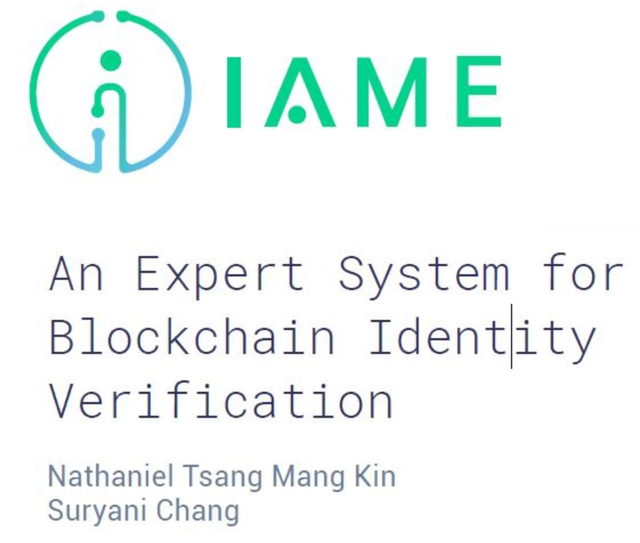
IAME totally depends upon its proprietary fragmented identification algorithm thereby identified documentation are fragmented into hundreds of incomprehensible bites. Also, they the validation procedure could be crowdsourced to the thousands of people. With IAME identification network value of identification is reduced to the fraction as well as fall out of safety breaches are condensed to nothing. Using the approved IAME identification network, we find to resolve the problems of parties in the blockchain. This decentralized identification system that allows parties performing the latest blockchain transaction verify on the initial stage.
A regular identification procedure begins out with the party acceding to the appeal by the counterparty to know itself. This is because the counterparty can ascertain the stage with whom it is operating or transacting. Then the party submits the data containing statement the counterparty posses deemed to be the corresponding and necessary supporting evidence. Later than mapping the entire data to the supporting proof, a decision is visited on whether the party identification could be ascertained.
The process assumes- if the part if right and legal then all given data statements would be mapped over supporting documentation. In code, the data that can be mapped on supporting documents, the more complex it is for the party to misrepresent its identity.
The process of mapping itself can be often simple and can be divided as follows-
• Statement of government history verification
• Statement to thread confirmation
• Statement to non-thread confirmation
• Statement to privately present details confirmation
• Statement to publicly present details confirmation
Any identification that may collect a maximum of the stated above mapping data is right for the counterparty that they are trading with an ideal person. Although, it may be disastrous for the sharing party, in the security breach programs as well.

Fragmenting the process of identification-
Constructing on the back identification process, the similar mapping systems can be got without the part revealing any inappropriate data to the counterparty. The statement is supporting the functions as well as evidence that will first have to be torn in a way the third party will be verifying fragments data. Through, the total sum of confirmation will constitute the full identification process.
An IAME identification network-
The IAME network will have a center that builds of- a validation server, a client and an allocation server, an identity server and a writeable blockchain. Every component will hold out certain systems which can be shown in two processes such as an identification process and a validation process.
Key Features
Fragmentation
In order to prevent disclosing any non-relevant data to a counterparty through identification, IAME delegates the mapping functions to unrelated third-party validators. The relevant data is fragmented so that the fragments can be used by the validators not affiliated with any parties operating as members of the transaction for the sole possible purpose of confirmation. One such fragment is otherwise completely useless should it fall into the hands of an unauthorized person.
Identification
Although the data is fragmented and each of the fragments is confirmed separately, this allows for complete identification. The validations sum up into the whole to finalize the identification process.

Validation
The above-mentioned validators are independent users. The validation process is facilitated with a mobile app making it possible to go through within a simple and clear interface. The app users earn IAM tokens for completing validation tasks.
Roadmap
The road of IAME begins with the proof of concept in the first quarter of 2018. They have recently completed the development of the peer-to-peer payment system. The roadmap is an implementation plan with milestones scheduled through early 2020.
The private sale of IAME tokens has been live since April 18th and will close on May 20th. They plan to run the first pre-sale from June 6th through June 10th, which will be followed by the second pre-sale starting on June 20th and ending on June 24th. Finally, the IAME ICO is scheduled for the period between July 4th and August 24th.
Team
The IAME team is headquartered in Quatre Bornes, Mauritius. It is comprised of:
Nathaniel Tsang Mang Kin, co-founder and Head of Compliance. Nathaniel’s previous experiences include mainly trading and investment management.
Suryani Chang, co-founder and back end / blockchain developer. Her LinkedIn profile features experience in IT as a consultant and lead development since 2004.
Chirag Patel, lead front-end developer. Alongside his role at IAME, Chirag holds the position of a lead Android developer at Syft where he has been working for the past three years. His career as a programmer began when he joined Mfuse Ltd as a JavaME developer.
Ari Vivekanandarajah, community manager. Since February 2017, Ari has been working as a marketing consultant for Hype Insight Global. His previous experiences include four years as Head of Marketing at Ecologital Limited, one year as a business analyst at Nadastra, Inc., and two years of training and assistance at DFCC Bank.
Ludovik Lejeune, front-end developer.
Kevin Chung-Fat, back-end developer.
Stephen Sunassee, UI designer.
IAME Homepage: https://iame.io/
IAME Whitepaper: https://iame.io/res/180301-IAME-White-Paper-en.pdf
IAME Twitter: https://twitter.com/@iameidentity
IAME Telegram: https://t.me/IAME_identity
By Arsenyo
https://bitcointalk.org/index.php?action=profile;u=893090